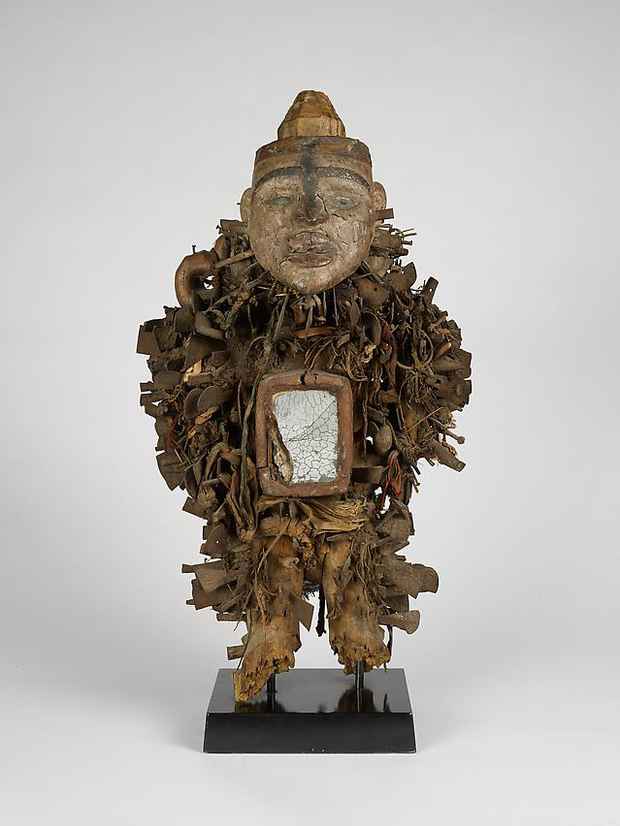“Arman the Collector: The Artist’s Collection of African Art” Exhibition
Paul Kasmin Gallery

This event has ended.
My dialogue with African art derives from the conviction that artistic creation arises from a common fund of humanity and that in the discovery of aesthetic solutions the making of masterpieces supersedes regions, cultures, and becomes part of the treasures from all places and all times of human creation. - Arman, in African Faces, African Figures: The Arman Collection (1997)
Paul Kasmin Gallery presents Arman the Collector: The Artist’s Collection of African Art, a selection of artworks and artifacts from the Arman Marital Trust’s renowned private collection, on view at 293 10th Avenue, New York, November 11, 2013 – January 11, 2014. The exhibition is comprised of twenty pieces from Arman’s collection of African Art. Arman, similar to artists like Picasso and Gauguin, was a leading collector of African art. His practice as a collector - such as artist-collectors Jeff Koons, Richard Prince, and Damien Hirst - was to collapse the distinction between Arman the collector and Arman the artist. For Arman, his approach to collecting and what he collected was in direct dialogue with his artistic practice; his iconic “accumulations” combined large numbers of similar objects (musical instruments, clocks, etc.) into singular, unified pieces. His collection of African Art can be viewed as an extension of the collector’s impulse seen in his work. According to Arman, “I collect because collecting is part of my makeup. I’ve always done it. I’ve always accumulated, much more than I’ve collected. And by accumulating, I’ve always been surrounded by objects.”
Arman’s collection of African Art began in 1955 with the purchase of the most important art from the Dan people of Liberia, and eventually grew to 300 – 400 pieces by the artist’s estimate. In Arman the Collector, the gallery will exhibit a provocative, ceremonial ibkomba Makonde face mask, formerly in the Tristan Tzara Collection; a byeri sculpture from Fang-Betsi that was believed to provide protection from the deceased and to aid in daily life; six Bundu helmet masks used for rites of divination and healing; and a nkondi from Kongo — a power figure that encapsulates the religious and spiritual beliefs of its makers. The exhibition also includes a Bwa nwantantay plank mask, used to represent moral codes and religious laws; a wooden Bamileke headcrest mask adorned with beads and embroidered fabric; an arugba bowl figure from Yoruba, believed to carry medicinal water; and other works from Arman’s exceptional collection. Framing the exhibition will be two sculptures by Arman showcasing the influence of African art on his creations.
Arman was born Armand Pierre Fernandez in Nice, France, 1928 and became a naturalized American citizen in 1973, when he officially changed his name to Armand Pierre ARMAN. His foundation as an artist began in 1946 at the L’École Nationale de des Arts Decoratifs de Nice, where he spent time painting in the Abstract tradition, due to in influence by Nicholas de Stael, while he studied archaeology and early epoch Chinese Art. In 1949, he moved to Paris, where he studied at the Ecole du Louvre, and where in 1954 he was introduced to the work of Kurt Schwitters, which led him to reject the lyrical abstraction of the period. By 1958, he had begun making his mark in the art world as a painter and sculptor and, at that time, he retained a printer’s misspelling of his name, from then on referring to himself as Arman. In 1960, Arman and his colleagues (Yves Klein, Martial Raysse, Daniel Spoerri, and Jean Tinguely), along with Pierre Restany, founded the avant-garde movement Nouveau Réalisme—unified in seeking “new perspective approaches of reality.” The group set out to reassess the role of art in an increasingly consumerist 20th century, and to reinsert humanism in the face of overwhelming industrialization and commodification. In 1961, Arman made his U.S. debut at The Museum of Modern Art, in William C. Seitz’s landmark exhibition, The Art of Assemblage. From 1961 onwards, he explored creation via destruction, namely in his Découpés and Colères, which included sliced, burned, or smashed objects arranged on canvas. Arman created monumental public installations worldwide, including Long Term Parking, 1976- 1982, a 50-foot-high column of concrete that encases dozens of cars, installed in the Parisian suburb of Jouy-en-Josas; and Hope for Peace, 1976- 1995, a 100-foot-high monument in Beirut, composed of five tons of concrete with 78 tanks, jeeps, and other war vehicles. Arman was honored for his contributions to public life in 1972, when the President of the French Republic decorated him as Chevalier de l’Ordre Du Mérite, and later with the medal of Legion of Honor.
Arman’s work has been exhibited internationally at museums and institutions, and is included in public and private collections worldwide, including the Museum of Modern Art, New York; the Stedelijk Museum, Amsterdam; the Walker Art Center, Minnesota; the Hirshhorn Museum and Sculpture Garden, Washington, DC; and the Musée d’Art Moderne de la Ville de Paris, France. In 2002, his Bicycle series was the subject of a major survey exhibition in Luxembourg, Arman: Les Cycles de Vie. In 2010, the Centre Pompidou, Paris, presented a comprehensive retrospective of his work. Arman died at his home in New York in 2005.
[image: Nkondi, Kongo, Power Figure, wood, nails, mirror, 29 x 14 x 10 1/2 inches.]
Media
Schedule
from November 11, 2013 to January 11, 2014
Opening Reception on 2013-11-11 from 18:00 to 20:00
Artist(s)
Arman Marital Trust et al.